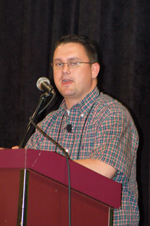Focus Breeding Objectives on Profitable Genetics,
Not Necessarily High-production Genetics
COLUMBIA, Mo. (June 29, 2010) — Matt Spangler, associate professor at the University of Nebraska-Lincoln (UNL), showed a simple equation to beef producers:
Profit = Revenue – Expense.
"Any questions," he asked, gesturing he was ready to walk off the stage at the 42nd Beef Improvement Federation (BIF) Research Symposium and Annual Meeting. It really is that simple, he joked, then offered to expound a bit.
 Matt SpanglerSpangler suggested that too much emphasis has been placed on the revenue side of the equation and not enough on the expenses involved in beef production. To prove his point, he showed a slide that indicated weaning weights and yearling weights have been increasing for the past 10 years.
Matt SpanglerSpangler suggested that too much emphasis has been placed on the revenue side of the equation and not enough on the expenses involved in beef production. To prove his point, he showed a slide that indicated weaning weights and yearling weights have been increasing for the past 10 years.
Spangler then asked the audience, “Is there too much milk production by mother cows?” After no quick answer, he explained himself. “Maybe instead of maximizing traits, such as milk production, we should optimize them. Optimizing will be more challenging, but it will be more efficient.”
Why would too much milk be a concern for producers? In addition to increasing input costs (the expense portion of the equation), it also increases the difficulty to rebreed, especially in rough environments, Spangler noted.
“We have to be concerned with input costs,” Spangler said. “We also must fit genetics to the producer’s production environment. Cattle cannot be placed in environments that will not work for them.”
Luckily, Spangler said, we have the tools to decide which cattle fit each producer’s environment and concerns. These tools include expected progeny differences (EPDs), especially EPDs for milk, mature weight, weaning weight and yearling weight.
“Watch these EPDs and their distribution curves for your replacement females,” Spangler advised. “Cull the ones that fall really low or high on the curve.”
The number of EPDs and genetic antagonisms between and among traits can be problematic, Spangler acknowledged. He suggested using economic index values, such as the American Angus Association’s maternal dollar value indexes ($Values), like weaned calf value ($W) and dollar energy ($EN), and terminal $Value indexes, like the beef value index ($B).
When using these, or other indexes, Spangler advised producers to use the ones that work best for their individual breeding objectives and to understand the associated population statistics and accuracy values.
To continue to move forward, producers must continue to turn information in, Spangler emphasized. “Record and turn in mature weights and body condition scores (BCS).”
He encouraged seedstock producers to track the costs of their commercial customers and practice multi-trait selection.
Spangler concluded by reminding the audience that optimum values, not maximum values, lead to profitability and that economic values are out there for both seedstock and commercial cattlemen to utilize to increase profitability.
“Some breeds will complement each other very well,” Spangler said. “Instead of maxing out one or two traits of those breeds, producers could work on optimizing more traits to possibly get a calf that would lead to more profitability for everyone.”
Themed "Gateway to Profit," the 2010 BIF Annual Research Symposium and Annual Meeting was hosted by BIF June 28-July 1 in Columbia.
Editor’s Note: This summary was written under contract or by staff of Angus Productions Inc. (API). Through an agreement with the Beef Improvement Federation, we are encouraging reprinting of the articles to those who will adhere to the reprint guidelines available on this site. Please review those guidelines or contact Shauna Rose Hermel, editor, at 816-383-5270. PowerPoints are posted with permission of the presenter and may not be reproduced in whole or in part without the express permission of the presenter.
API's coverage of the event is made possible through collaboration with BIF and sponsorship by BioZyme Inc. through its significant gift to the Angus Foundation. For questions about this site, or to notify us of broken links, click here.
Headquartered in Saint Joseph, Mo., API publishes the Angus Journal, the Angus Beef Bulletin, the Angus Beef Bulletin EXTRA, and the Angus e-List, as well as providing online coverage of events and topics pertinent to cattlemen through the API Virtual Library.



